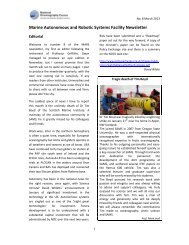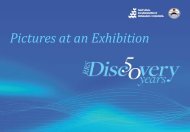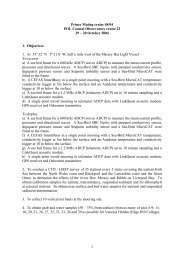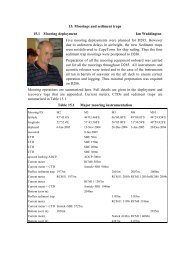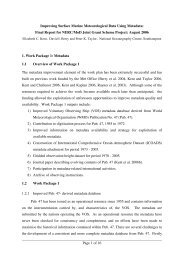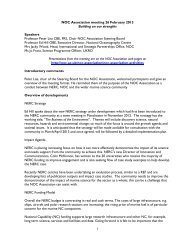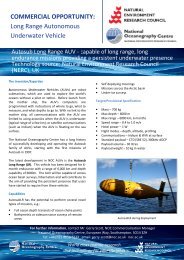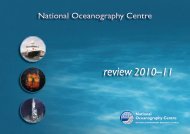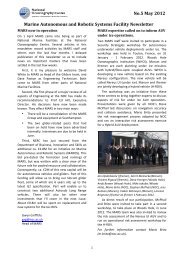Microlander NOC flyer.pdf - National Oceanography Centre
Microlander NOC flyer.pdf - National Oceanography Centre
Microlander NOC flyer.pdf - National Oceanography Centre
- No tags were found...
Create successful ePaper yourself
Turn your PDF publications into a flip-book with our unique Google optimized e-Paper software.
COMMERCIAL OPPORTUNITY:<br />
MicroLander - rapidly deployable<br />
sea bed lander system<br />
Self-deploying, disposable tripod lander, easily launched from<br />
aircraft or a range of vessels<br />
Technology source: Natural Environment Research Council<br />
(NERC), UK<br />
The Invention/Expertise<br />
The <strong>National</strong> <strong>Oceanography</strong> <strong>Centre</strong> has a<br />
long history of developing lander (pop-up)<br />
instrument platforms for use in the deep<br />
ocean and continental shelf.<br />
The MicroLander builds on this expertise and<br />
has been designed as a more compact<br />
platform that can easily be deployed from<br />
aircraft or any ship of opportunity.<br />
MicroLander is designed to be disposable<br />
and send data back to base via satellite or<br />
acoustic telemetry.<br />
The system has a self-deploying, tripod<br />
ballast frame that provides a stable platform<br />
for the sensor package to sit on. At the end<br />
of the deployment, the tripod frame can be<br />
released (e.g. under timer control) and the<br />
buoyant instrument package returns to the<br />
surface for collection or transmission of data<br />
via satellite.<br />
System Overview<br />
<strong>Microlander</strong> consists of a tubular package<br />
1.65m long and 127mm diameter. The upper<br />
part of the package is a buoyant instrument<br />
tube which houses the battery pack, data<br />
logging and sensor interfaces. Mounted on<br />
the top end cap are the sensors, data<br />
telemetry antenna and hydrophone<br />
transducer (if required).<br />
Below the sensor tube is the landing<br />
mechanism consisting of three heavy<br />
lead feet which fit together tightly<br />
when in the pre-deployment<br />
configuration. These are attached to<br />
steel legs which have pivot points for<br />
the legs to swing out into the fully<br />
deployed state. The deployed lander<br />
has a footprint diameter of 1.2m,<br />
giving good stability on the seabed.<br />
Device Operation<br />
MicroLander uses a pneumatic piston<br />
to operate the lander tripod. During<br />
deployment, a locking mechanism<br />
prevents the legs from opening until<br />
operating depth is reached.<br />
Increasing sea pressure during descent<br />
to the sea bed acts on the piston and<br />
drives it out. Once operating depth is<br />
reached, the landing mechanism is<br />
locked and cannot retract.<br />
The lander deploys fully at around 45<br />
to 50m depth (although this could be<br />
altered by design) and is then in a<br />
stable configuration for descent to the<br />
seabed. The relatively large area of the<br />
lander pads stops the instrument<br />
sinking into the sediment and provides<br />
a stable platform.<br />
Undeployed MicroLander<br />
(the grey legs are a stand, not<br />
part of the instrument)<br />
For further information, contact Mr. Gerry Scott, <strong>NOC</strong> Commercialisation Manager<br />
<strong>National</strong> <strong>Oceanography</strong> <strong>Centre</strong>, European Way, Southampton. SO14 3ZH<br />
Tel: +44(0)23 8059 6223 email: gerry.scott@noc.ac.uk noc.ac.uk<br />
<strong>National</strong><br />
<strong>Oceanography</strong> <strong>Centre</strong><br />
NA TUR A L ENVIR ONM E NT R ESEA R C H C OUNC I L<br />
World class marine research<br />
and technology for your business<br />
NATURAL<br />
ENVIRONMENT<br />
RESEARCH COUNCIL
COMMERCIAL OPPORTUNITY:<br />
MicroLander - rapidly<br />
deployable sea bed lander<br />
system<br />
Instrument Recovery<br />
Recovery of the instrument package is achieved by<br />
operating a release mechanism between the lower<br />
tube end cap and the top of the lander tripod.<br />
This system has not yet been fully implemented, but is<br />
envisaged that it could consist of a “burn-wire”<br />
system, corrodible bolts and/or a threaded bolt<br />
controlled by motor and gearbox. An acoustic release<br />
system could also be used. The end cap is also big<br />
enough to accommodate an acoustic transducer for<br />
data transmission, although the operating life may be<br />
limited by the size of the battery in the instrument<br />
housing.<br />
After release, the instrument tube rises to the sea<br />
surface using its own buoyancy at a rate of around 1.0<br />
metres per second.<br />
Once on the surface, the instrument tube floats with a<br />
few inches of the tube out of the water, sufficient for a<br />
good line of sight to the sky for satellite<br />
communication.<br />
The Opportunity<br />
<strong>Microlander</strong> has undergone successful test<br />
deployment at sea, as well as testing in a<br />
pressurized test tank.<br />
<strong>NOC</strong> is interested in finding a commercial partner<br />
who understands the capabilities and potential<br />
markets for MicroLander and would be interested<br />
in manufacturing and marketing the device under<br />
licence from NERC.<br />
For further information, contact Mr. Gerry Scott, <strong>NOC</strong> Commercialisation Manager<br />
<strong>National</strong> <strong>Oceanography</strong> <strong>Centre</strong>, European Way, Southampton. SO14 3ZH<br />
Tel: +44(0)23 8059 6223 email: gerry.scott@noc.ac.uk noc.ac.uk<br />
<strong>National</strong><br />
<strong>Oceanography</strong> <strong>Centre</strong><br />
NA TUR A L ENVIR ONM E NT R ESEA R C H C OUNC I L<br />
World class marine research<br />
and technology for your business<br />
The information in this Project Profile is provided "as is" without conditions or warranties and NERC makes no representation and gives no warranty that it is<br />
the owner of the intellectual property rights in the technology described.<br />
World class marine research<br />
and technology for your business<br />
Tripod stage in deployed state, showing steel legs and<br />
lead pads/feet<br />
NATURAL<br />
ENVIRONMENT<br />
RESEARCH COUNCIL



